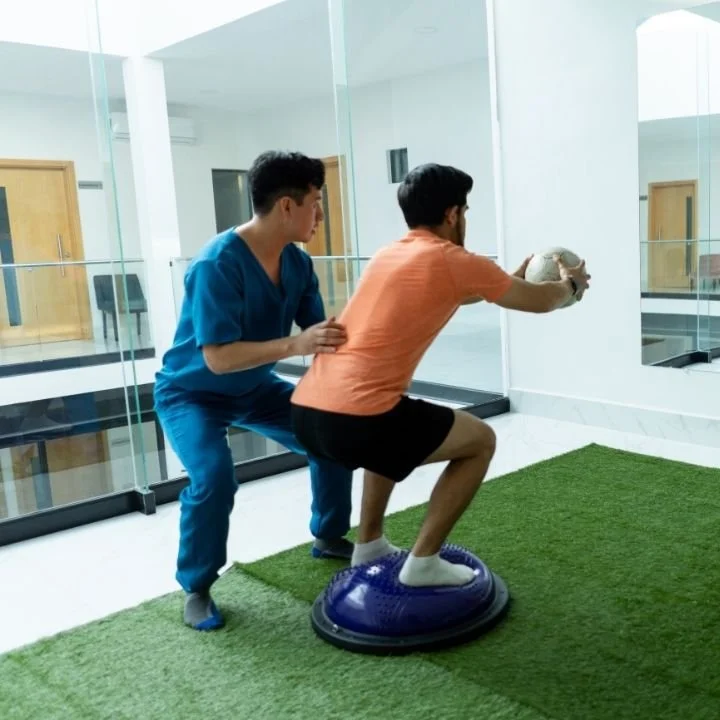When to See a Sports Physical Therapist: Key Signs to Know
If you're dealing with pain, joint discomfort, or mobility issues from training or sports activities, knowing when to see a sports physical therapist is essential. Ignoring these symptoms can lead to prolonged recovery and potential long-term damage. Early intervention with a specialized physical therapist can speed up recovery, prevent complications, and get you back to your active lifestyle safely.
As experts in injury rehabilitation and performance enhancement, we understand the importance of timely care. In this guide, we’ll walk you through when to visit a sports physical therapist, what to expect, and why early treatment is key.
Understanding Sports Physical Therapy
Sports physical therapy is a specialized branch of physical therapy that addresses the prevention, evaluation, treatment, and rehabilitation of injuries caused by sports and physical activities.
Unlike general physical therapy, sports PT incorporates advanced knowledge of biomechanics, sports medicine, and athletic performance. Sports physical therapists (PTs) are trained to understand the unique demands of athletes and active individuals, assessing how injuries impact performance and overall function.
A key component of sports physical therapy is not just recovery but also enhancing performance. According to a study, sports physical therapy addresses unique demands of athletes with tailored evaluation and treatment strategies. PTs work with athletes to design customized treatment plans that target the specific needs of their sport or activity. Whether it’s recovering from an injury or optimizing movement patterns to prevent future problems, sports PT focuses on getting athletes back to their highest level of function, faster and more safely.
Signs You Need to Visit a Sports Physical Therapist
1. Acute Injuries Requiring Immediate Attention
Acute injuries like sprains, strains, fractures, or tears require prompt evaluation. If pain or swelling doesn’t improve after a few days, or mobility changes become noticeable, a sports physical therapist should be seen. These therapists assess the injury’s severity and initiate rehab injury protocols to restore function and prevent long-term damage.
2. Dealing with Chronic Injuries and Joint Pain
Chronic injuries or persistent joint pain that limit sports performance or daily activities are indications to see a sports physical therapist. Long-standing issues can worsen without appropriate treatment, leading to reduced muscle strength, function, and health. PTs help address biomechanical imbalances and guide long-term injury rehabilitation.
3. Difficulty with Mobility or Balance
If you're experiencing difficulty or changes in mobility, balance, or coordination, it's a sign to consult a sports physical therapist. These issues can be linked to a variety of conditions, including injury recovery, neurological conditions, or muscle imbalances.
Physical therapists are skilled at identifying the underlying causes of these difficulties and can guide you through exercises to improve stability and prevent further falls or injuries.
4. Limited Range of Motion
Based on the overview from ScienceDirect, joint mobility refers to the normal range of motion of a joint and can be limited by injury or disease. A reduced range of motion in a joint or muscle often results from injury, overuse, or aging. If you notice stiffness or an inability to fully move a joint, such as your shoulder, knee, or back, a sports physical therapist can develop a program to restore mobility, reduce pain, and prevent future problems by addressing soft tissue tightness or joint dysfunction.
Post-Surgical Rehab and Recovery
After undergoing orthopaedic surgery, a structured rehabilitation plan is crucial to ensure proper recovery. Sports physical therapists specialize in post-surgery rehab, guiding patients through targeted exercises designed to restore strength, improve joint mobility, and promote overall recovery.
In addition to rehabilitation, these therapists also incorporate performance therapy to help patients regain optimal physical function. They focus on pain management, reducing inflammation, and speeding up the return to both daily activities and sports. Post-surgical rehabilitation is tailored to each individual’s needs, addressing the specific demands of their sport or lifestyle to optimize recovery and enhance performance outcomes.
When Sports Physical Therapy Can Improve Performance
Sports physical therapy isn't just for injury recovery, it's also a powerful tool for enhancing athletic performance. Athletes may seek out a sports PT for advice on optimizing their biomechanics, improving muscle conditioning, and developing performance strategies that reduce the risk of injury.
By addressing weaknesses, muscle imbalances, or movement inefficiencies, sports PTs can help athletes improve endurance, strength, and overall function. This approach focuses not just on treating existing injuries but on enhancing physical capabilities to reach peak performance levels, thus preventing future injuries and fostering long-term athletic success.
What to Expect During Your Sports Physical Therapy Visit
Here are the key steps you can expect during your sports physical therapy visit, services designed to help you recover, prevent future injuries, and enhance performance.
Initial Assessment: The first visit includes a comprehensive discussion of your injury history, current symptoms, and sports participation.
Evaluation: The physical therapist will evaluate your physical condition through exams and possibly imaging studies.
Personalized Treatment Plan: A tailored plan will be developed, combining manual therapy, therapeutic exercises, and modalities like heat or ice therapy.
Regular Follow-up Visits: Ongoing visits monitor your progress, allowing therapists to modify exercises and treatments as needed based on your recovery.
Education & Support: Physical therapists educate you on managing your condition, preventing future injuries, and supporting long-term injury rehabilitation.
Common Conditions Treated by Sports Physical Therapists
Sports physical therapists address a variety of conditions, including:
Acute injuries such as sprains and fractures
Chronic injuries and joint pain
Overuse injuries from repetitive sports motions and training
Post-concussion and vestibular rehabilitation
Muscle strains and biomechanical dysfunctions
This specialized care ensures athletes receive targeted treatment that promotes healing and restores peak physical function.
Benefits of Early Intervention and Professional Care
Seeking care early with a sports physical therapist has multiple benefits:
Prevents worsening of acute injuries and progression to chronic pain
Optimizes recovery through guided rehab injury protocols
Enhances athletic performance and reduces re-injury risk
Provides education on injury prevention and sports medicine
Ignoring symptoms or delaying treatment can lead to prolonged pain, decreased function, and missed sports participation.
Get Back to What You Love
Knowing when to see a sports physical therapist can be a game-changer for both recovery and performance. Timely intervention can help you recover faster, prevent long-term issues, and even enhance your athletic abilities. At Physio Chicago, we prioritize personalized care, expert injury rehabilitation, and performance enhancement. If you're recovering from surgery, managing chronic injuries, or aiming to optimize your sports performance, our team is here to help.
Don’t wait for discomfort to hold you back. Contact us today to schedule your appointment and get back to doing what you love.
Frequently Asked Questions
What is injury rehabilitation and how does physical therapy help?
Injury rehabilitation involves restoring function and strength after an injury. Physical therapy (PT) is vital in this process, providing targeted exercises and manual care to reduce pain, improve mobility, and aid recovery. Sports physical therapists create personalized rehab injury plans to ensure safe and effective healing.
When should I see a physical therapist for sports-related injuries?
You should see a physical therapist (PT) soon after experiencing acute injuries such as sprains or strains, or if joint pain and chronic injuries persist. Early PT intervention optimizes injury rehabilitation, prevents worsening conditions, and supports a speedy return to sport or daily activities.
How does physical therapy enhance injury rehabilitation for athletes?
Physical therapy enhances injury rehabilitation by addressing muscle imbalances, joint pain, and mobility changes. Sports physical therapists develop customized treatment plans involving exercises and manual therapy to restore function and strength. This approach ensures effective healing and minimizes the risk of future injuries.
Can PT help with chronic injuries and joint pain?
Yes, physical therapy plays a crucial role in managing chronic injuries and joint pain by improving muscle strength, flexibility, and joint function. PTs use specialized techniques in sports therapy to reduce pain and enhance overall health, enabling athletes and active individuals to perform better and recover faster.
What can I expect during my first sports physical therapy visit?
During your first visit, a physical therapist will assess your injury through history-taking, physical exams, and possibly imaging. They design a tailored injury rehabilitation plan with exercises, manual therapy, and education. This personalized approach aims for optimal recovery, pain relief, and function restoration.









